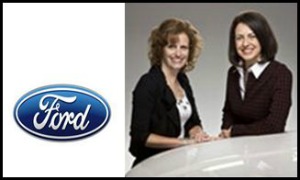Every few months we feature one of the pioneers that make up the ThirdPath community . . . This month we are putting a spotlight on a highly successful job share.
Julie Levine and her work colleague, Julie Rocco, have successfully job shared a management position at Ford Motor Company for more than 5 years. Read on to learn about these pioneering, or click the SoundCloud icon at the end to listen to them share their inspiring story.
Job sharing a program manager position with Julie Rocco, Julie Levine soon discovered how “fully integrated” they had become – sometimes even asking the same questions at the exact same time. In fact, the trust that has built up over the years leaves both parties with complete faith they will be well represented by the other during their absence. It has also provided the ease of mind the “two Julies” needed to be able to spend time with their families.
This collaborative partnership, Julie jokes, has almost been like a “marriage” at work. She also underscores how it did not come about by just placing two people in a job share arrangement. There were numerous factors that played into its success, the most critical being the selection of the right people to create the job share. Julie talks about how she and Rocco went on a “blind date” to figure out whether or not they would be compatible. During this “date” they both took time to assess whether they shared a similar sense of responsibility for getting the work done as well as attention to detail, energy levels and integrity.
After finding each other, the next critical step was pitching the business case for moving ahead. They needed to show the company that “the sum of two Julies…” was really better than “…two Julies alone.” Julie describes how both of them having strong reputations within the organization helped make their case. But they also began to quickly see how their job sharing arrangement brought many advantages to their organization.
For example, having the network and experience of two people on any one task or problem offered a significant benefit to their employer; playing into the old cliché – two heads are better than one. Julie also talks about how refreshed she would be from her time away from work. Even vacations played out differently. When one of them took a vacation, the other was still available to work at half time, so projects were able to continue to move forward. At one point, they were even able to turn a maternity leave into an opportunity to have a junior employ gain exposure to a higher level position. The employee was even promoted after the leave was up!
While the benefits to the company were plentiful, the advantages to Julie and her family were immeasurable. Julie cites many tangible things such as being able to volunteer at her children’s school as well as have time for exercise and other activities. She also talks about some of the more intangible benefits such as having her children grow up in an environment where they see that Mommy’s career is just as important as Daddy’s; and that balancing work and family is possible.
Julie concluded with advice on what she learned through the years to be key attributes to her job sharing success:
· Being seamless: never having to ‘burden’ your fellow employees (i.e. by having them repeat information twice). It doesn’t matter which person you talk to, both would always be up-to-date on any and all matters.
· Being completely consistent: making sure that directions, and answers to questions, are handled in a similar manner.
· Being fully committed: committing to the necessary time and effort to ensure their success, such as the update process they use four times a week to be bring each other up to speed on what happened that day.
· Sharing the entire job – not just splitting tasks: This is critical for both being seamless and consistent, as both parties are then aware of everything relevant to their job.
Julie’s story is another great example of how we can “redesign leadership” in a way where everyone benefits – the leader, the leader’s family as well as the organization. To listen to more of Julie Levine’s story, click the SoundCloud link below.

